Team-BHP
(
https://www.team-bhp.com/forum/)
Amphibious Squadron of the Indian Navy (IN)
Amphibious vessels fall into two broad categories - those that roll onto the beach and those (typically much larger) that carry landing crafts or hovercrafts in their belly which in turn are disgorged onto the beach. As of now landing ships of various sizes from 200 tonnes to 6000 tonnes are preferred to land men and machines and supplies onto a gently sloping beach due to their carrying capacity. Hovercraft offer greater flexibility of being able to glide over marshes and non-beach but flat coastal areas but at the cost of limited payload carrying capacity and range.
The hull design: Diagramme below is a scale model of the 280 foot long LST [Landing Ship (Tank)] INS Cheetah of the Russian Polnocny class and depicts the wedge shaped hull design of landing ships (when viewed from the side). Hulls of amphibious vessels are broad, shallow with a buff flat bow and without the V shape needed for speed and stability. Hence they are by design slow, typically 12 to 16 knots (~22 to 30 kmph) and poor seaboats i.e. they roll and pitch more than a traditional hull.
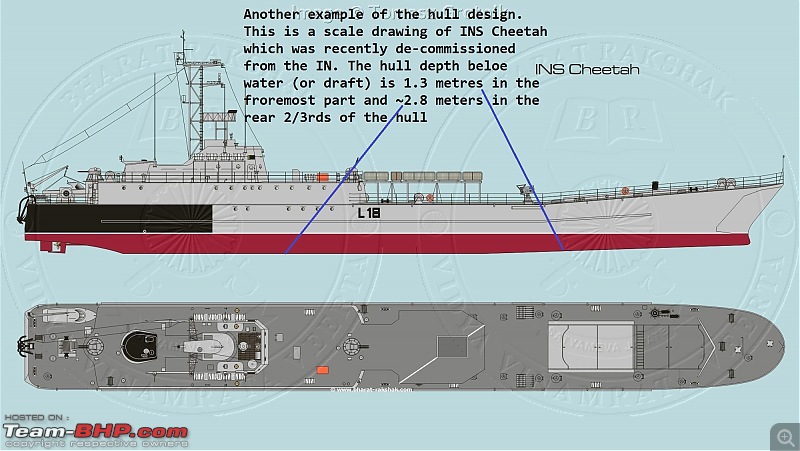 Getting onto the beach
Getting onto the beach: When beaching, the ship comes in with ballast tanks partly full keeping it lower and more stable in the water. It is an art to judge what speed to beach at - typically between 2 to 3 knots and when to deploy the stern anchor so that you donít stop too soon ie in say 9' deep waters or go charging up the beach and damage your propellers and rudders.
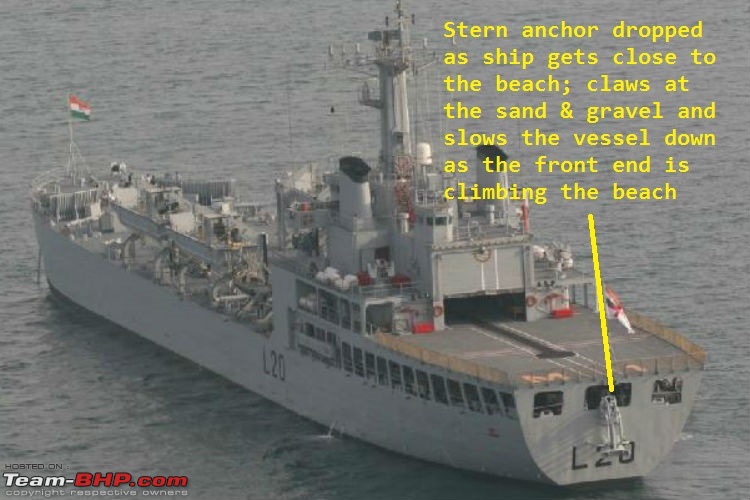 Getting off the beach
Getting off the beach: While discharging its payload of troops, machines and supplies the vessel by definition gets lighter. This creates the risk of the ship beginning to float freely due to bouyancy. You donít want a 5000 tonne, 400' long vessel afloat loose on a crowded beach swinging around the stern anchor pivot! So while discharging the ship fills in its ballast tanks slowly to make it more stable and to keep it grounded on the beach while unloading. When it's time to go you blow the ballast tanks, let Archimedes' principle do its job and reverse your propellers.
The Magar/Shardul class LST - our mainstay: In the 1980s India decided to build its own landing ships and went for the largest design we had access to. Typically landing ships that can beach are in the 200 to 3000 tonnes range but a British design went up to the 5600 and an American one to the 10,000 tonne range. The British sold us the design of the successful Sir Lancelot class which we modified to our tropical environment and operating protocol and fitted with power plants being license built in India from SEMT Pielstick. The Sir Lancelot or Round Table class was a sound design and the Australians too did what we did - buy the design and build to your specifications. We put 5 into service slowly over 20 years from 1987 - the first two are called the 'Magar' class and the next 3 with improvements the 'Shardul' class.
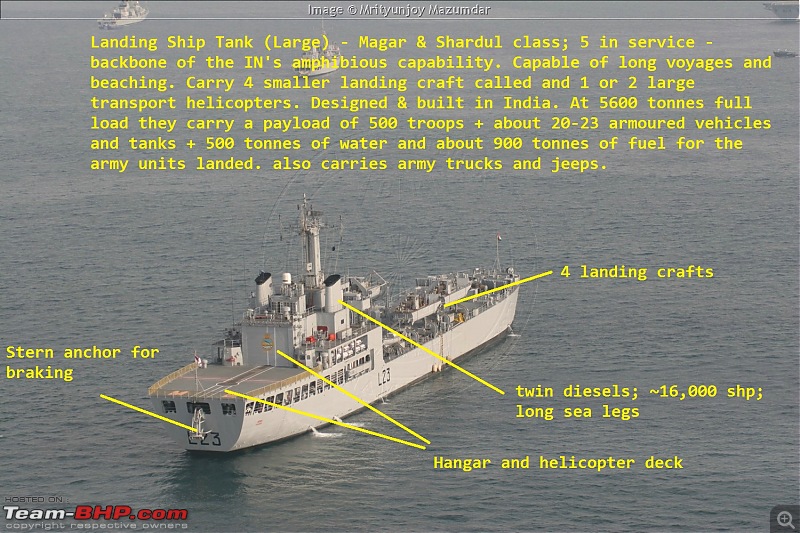
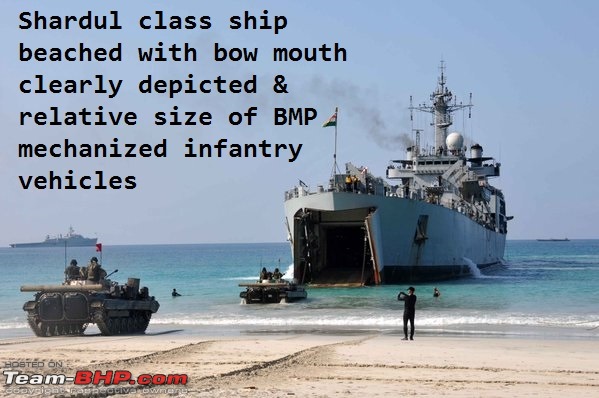
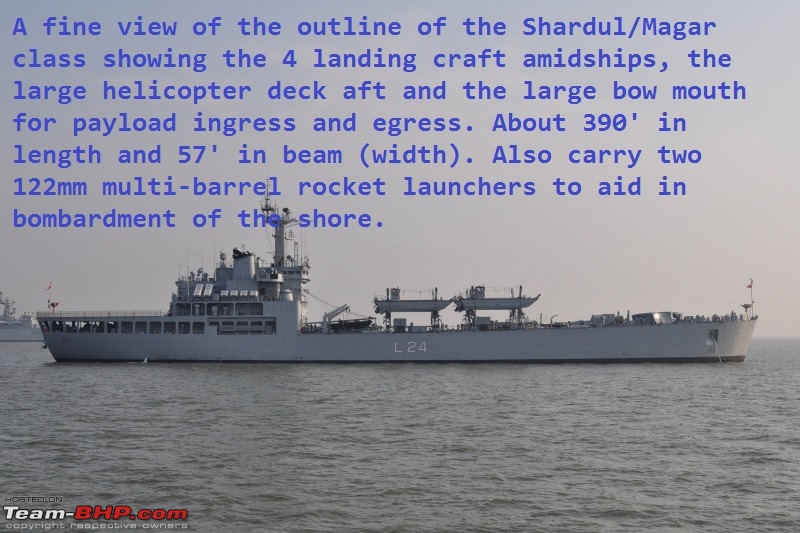 Kumbhir Class LST (Polnocny class)
Kumbhir Class LST (Polnocny class): For all practical purposes our modern amphibious story started in 1966 with the induction of 2 Russian Polnocny class LST (Landing Ship Tank). These were medium sized ships of ~1150 tonnes displacement and could transport and deliver 8 to 10 armoured vehicles and ~150 troops. Between 1966 and 1987 a total of 10 were bought of which 3 called the Kumbhir class are still in service but now long in the tooth. Before 1966 we had one ex-British LST of WW-II vintage but its utility was limited by age.
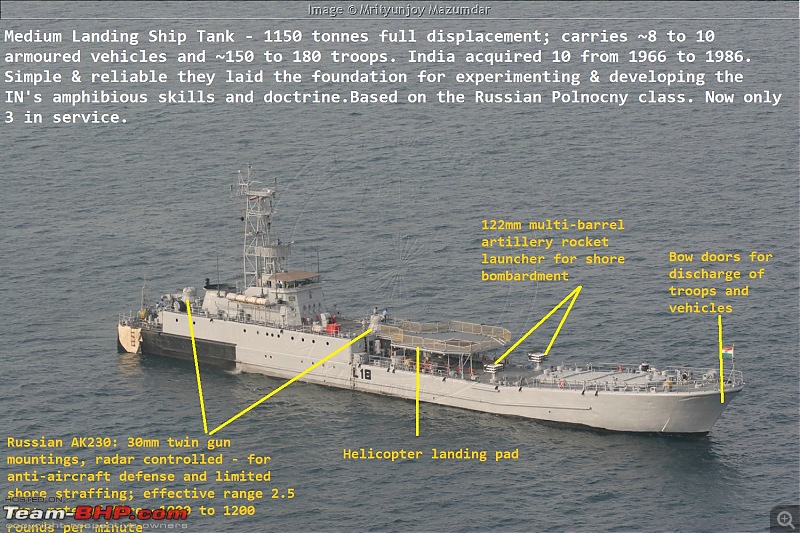
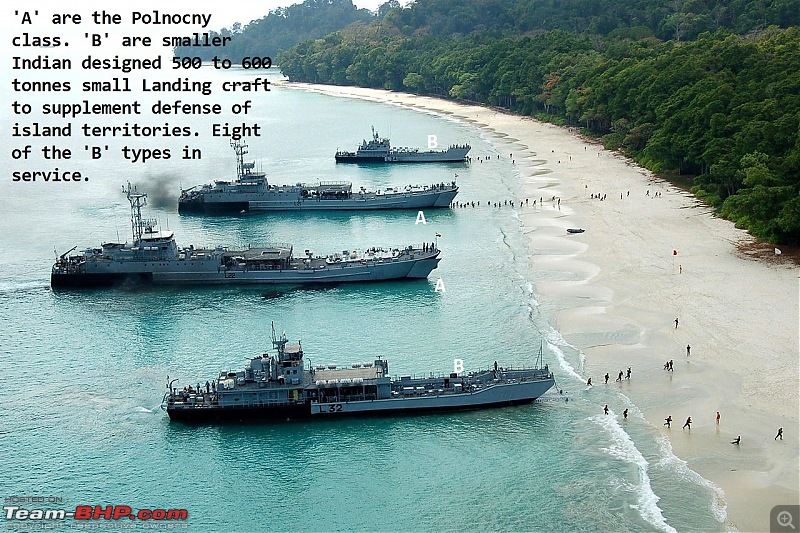
A new 800 tonne Landing Craft Utility (LCU) is entering service; 6+ are on order. They will replace the Polnocny and the smaller landing ships shown above.
INS Jalashwa - the queen, for now: In 2007 the IN acquired its first ever ship from the US Navy. INS Jalashwa (Hippopotamus in Hindi) is a large amphibious ship capable of fast sailing to the point of attack and then off loading its payload via landing craft and helicopters. The Americans offered us two refitted ships but we took only one despite the attractive price. Those were the days of a certain defence minister known for his inability to take decisions or let anyone else take them. Jalashwa is a 'Austin' class LPD a US/NATO nomenclature meaning Landing Platform Dock. while Jalashwa is a little long in the tooth it could serve us for another 7 years and has given the IN invaluable experience at handling a large amphibious ship.
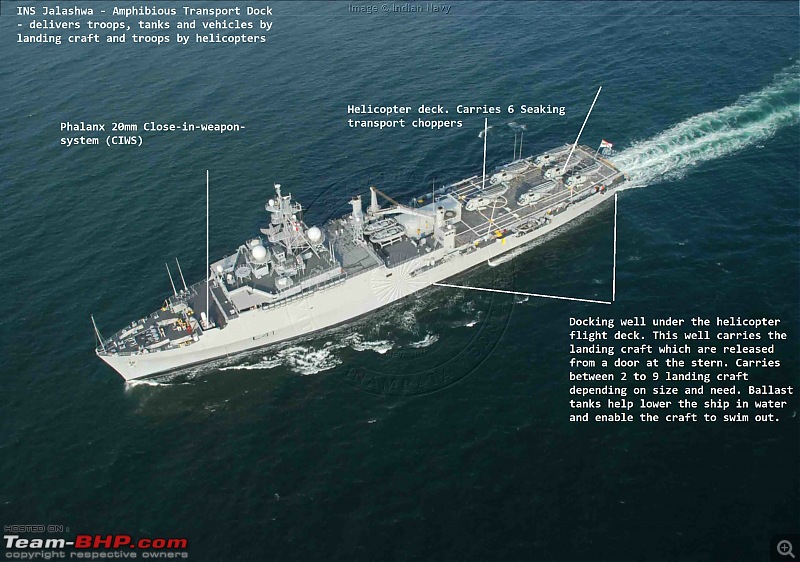
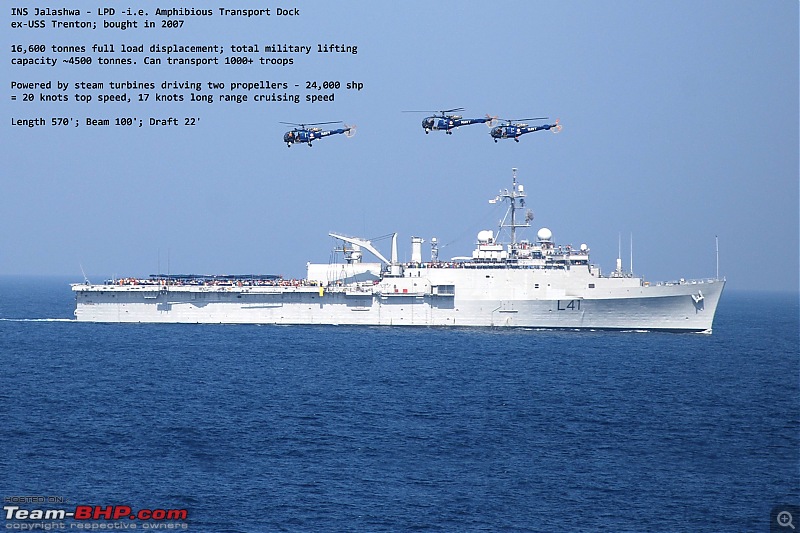
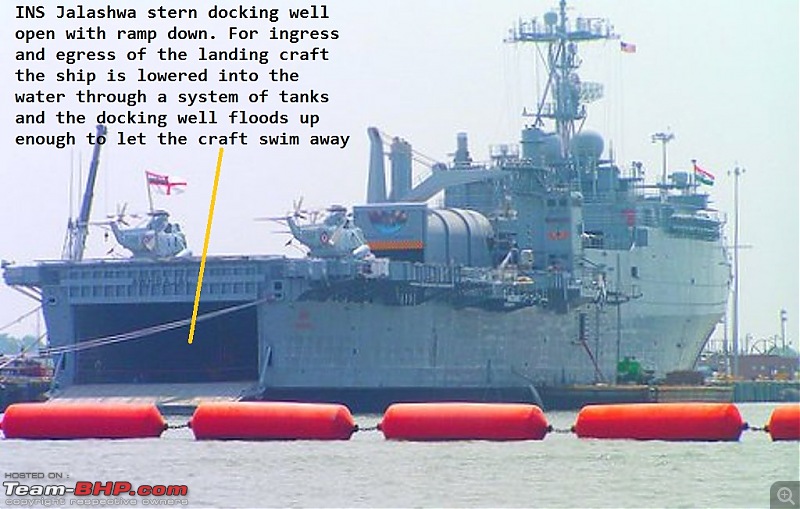
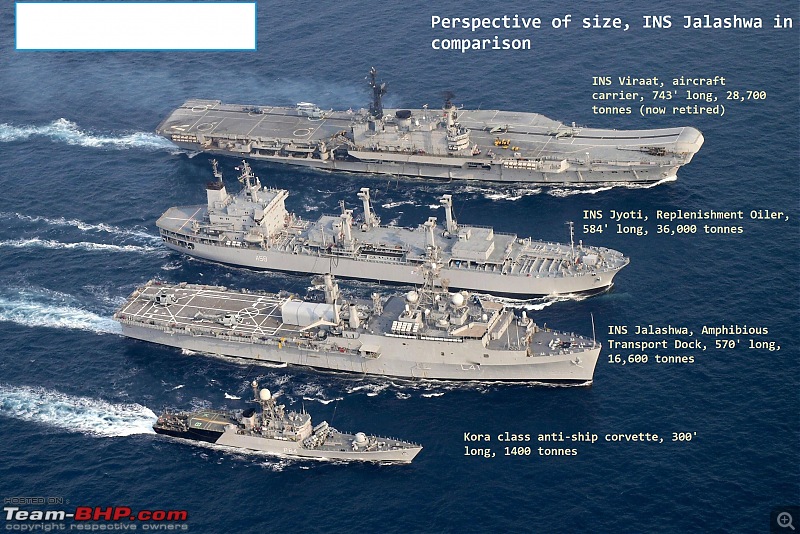
INS Jalashwa carries certain U.S. restrictions on offensive deployment. Now that India and the U.S. are getting closer as allies this may not be a major issue. The vessel underwent a deep refit in 2012 and received a new upgraded, Indian developed/integrated suite of radars, sensors, action information systems, ECM etc.
The Future: The IN has put out a tender for 4 multi-purpose amphibious assault ships that can carry helicopters and landing craft and a military payload of 6 tanks, 20 armoured vehicles, 40 heavy trucks and operate upto 10 heavy choppers for transport and attack roles. It should have requisite command & communications facility, on-board hospital, repair workshop and other support infrastructure. Fincantieri's rendition of what it could look like.
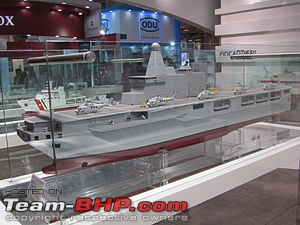
Amphibious operations are amongst the most complex military operations. It involves the surface fleet, naval carrier aviation, the army (or marines), attack helicopters direct air support and depending on range, the Air Force. Before a beach assault the beach needs to be covered by a reconnaissance mission on depth, slope, underwater obstacles not to enemy mention defences and all this needs to be done discreetly. In today's age of satellite reconnaissance a beach assault would find it difficult to be done with surprise so the attacking forces need to be equipped for a over whelming attack. In terms of complexity of large naval operations amphibious assault comes on top of the list. It is heartening to see the IN developing its capability in this sphere.
The fleet size of Indian Navy amphibious vessels is quite large - especially when you look at it as a percentage of overall Navy fleet size (including submarines). I'm assuming the entire amphibious fleet is for the defense of Andaman and Nicobar Islands? Or are we planning to invade Sri Lanka sometime in the future?
During peacetime, I guess there are lots of uses for these vessels. Eg: supplying water to Maldives, evacuation of civilians from Yemen, supply of relief material during 2004 Indian Ocean Tsunami etc
Quote:
Originally Posted by V.Narayan
(Post 4258649)
Hulls of amphibious vessels are broad, shallow with a buff flat bow and without the V shape needed for speed and stability. Hence they are by design slow, typically 12 to 16 knots (~22 to 30 kmph) and poor seaboats i.e. they roll and pitch more than a traditional hull.
|
Aah, okay. It's all about the hull design.
Quote:
Originally Posted by smartcat
(Post 4258666)
The fleet size of Indian Navy amphibious vessels is quite large - especially when you look at it as a percentage of overall Navy fleet size (including submarines). I'm assuming the entire amphibious fleet is for the defense of Andaman and Nicobar Islands? Or are we planning to invade Sri Lanka sometime in the future?
|
Someone once said, famously, that in matters military 'don't focus on intention focus on capability.' Capability takes a generation to build while your intentions can change overnight. We don't wish to invade Sri Lanka or any neighbouring country but it pays to develop your capability for eventualities that may seem afar today - (i) with non-State actors developing an uncomfortable presence; and (ii) you never know what China might do in the next 20 years in our neck of the woods; and (iii) it is nice to be able to carry a big stick to show our not so stable western neighbor. If we don't prepare for eventualities we cannot forsee then when the need comes our preparation will be 20 years out of date.
A multi-purpose 20,000 tonne amphibious assault ship is a complimentary to a carrier. It can also be used as an escort carrier or centerpiece of an ASW squadron. The power projection that such assets represent is why UK and France with their much diminished fleets (since the end of the cold war) continue to commission modern amphibious assault ships.
Quote:
During peacetime, I guess there are lots of uses for these vessels. Eg: supplying water to Maldives, evacuation of civilians from Yemen, supply of relief material during 2004 Indian Ocean Tsunami etc
|
Yes in peace time these are very useful multi-purpose ships - rescue, hospital, relief, shelter etc. Also in case of a natural disaster they don't need a functional port and they are self sufficient with their own crane(s) and large boats.
Many thanks for sharing, V.Narayan! Moving your lovely post to its own thread :thumbs up.
Quote:
Originally Posted by V.Narayan
(Post 4259392)
Someone once said, famously, that in matters military 'don't focus on intention focus on capability.' Capability takes a generation to build while your intentions can change overnight. it pays to develop your capability for eventualities that may seem afar today
|
Looks like Mr. Someone has read HISTORY ;)
Did some more research. For those interested in strategic affairs and geo-politics, this map gives an idea about importance of Andaman & Nicobar islands for India - and by extension of that, importance of Indian Navy amphibious fleet.
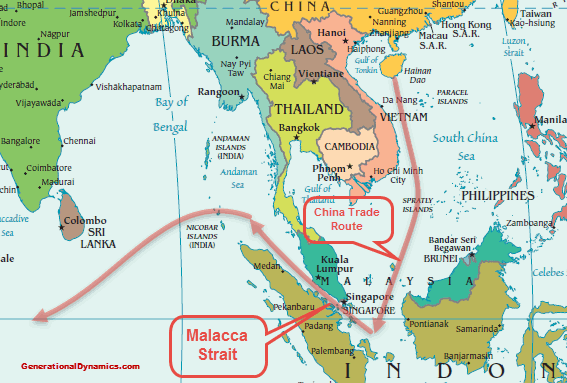
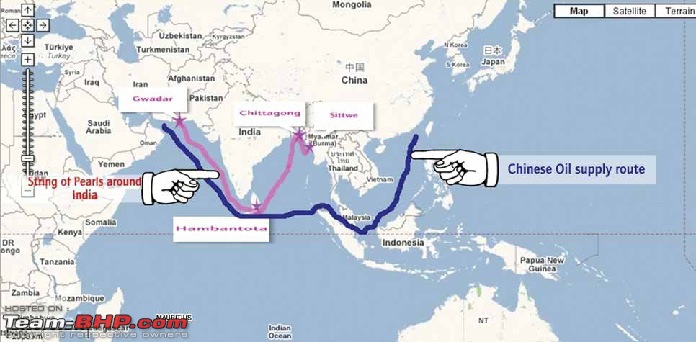
80% of China's oil imports (and majority of China's trade with Africa & Middle East) passes through Andaman & Nicobar Islands via Malacca Strait (via Singapore). A much longer alternative route is available but that takes it closer to Australia, which is an Indian ally when it comes to containment of China.
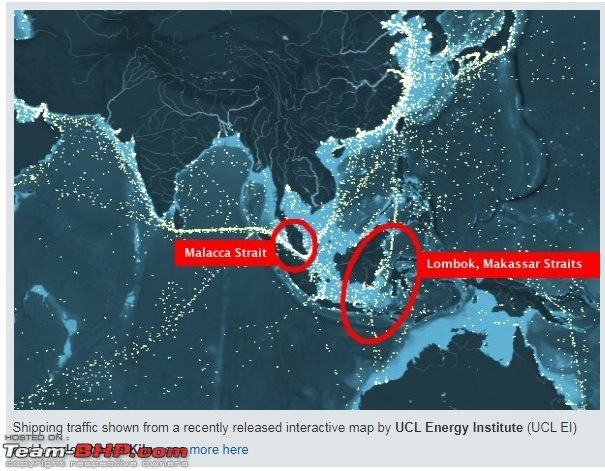
Read more at:
http://www.futuredirections.org.au/p...cobar-islands/
Quote:
Originally Posted by smartcat
(Post 4260260)
80% of China's oil imports (and majority of China's trade with Africa & Middle East) passes through Andaman & Nicobar Islands via Malacca Strait (via Singapore). A much longer alternative route is available but that takes it closer to Australia, which is an Indian ally when it comes to containment of China. Attachment 1670872
|
That's probably one of the reasons China wants to build the One Road One Belt (Or whatever it is) corridor, connecting Europe and Middle east through land and thereby bypassing, at least to some extent, India's strategic control of its trade route.
I'm a general citizen and I am unsure of how much of the information and extremely specific data points being shared in this thread is genuinely public information and how much otherwise has been opened up here. I request the thread creator and further posters to kindly provide only completely public information here on this sensitive topic.
Quote:
Originally Posted by latentpotential
(Post 4260400)
I'm a general citizen and I am unsure of how much of the information and extremely specific data points
|
Trust me, these are not at all sensitive info. You can get all these in public domain. What the thread creator has done is, educate us. Relax. BTW - I remember once a CIA top boss told, what is the use of deploying more operatives and networks when your ministers and bureaucrats play that role.
Quote:
Originally Posted by smartcat
(Post 4258666)
The fleet size of Indian Navy amphibious vessels is quite large - especially when you look at it as a percentage of overall Navy fleet size (including submarines). I'm assuming the entire amphibious fleet is for the defense of Andaman and Nicobar Islands? Or are we planning to invade Sri Lanka sometime in the future?
.
|
Quote:
Originally Posted by V.Narayan
(Post 4259392)
.
|
Narayan Sir has already answered this point. However a couple of interesting points.
A Large Amphibian is like a naval multi-tool. There has been cases where large amphibians with their massive inner space have been used to transport smaller submarines (like a dry dock). It can, in a pinch also act as a resupply vessel to other ships. The Harrier was designed to land on such ships. Due to the ability to operate in shallow water, smaller boats of this class can also function as river craft. Also, like Narayan sir has pointed out, it will act as a part of a larger flotilla. Imaging a naval flotilla with the VikAd (INS Vikramaditya) as the center piece, with two Delhi/ Kolkata/ Vishakhapatnam Class destroyers, Two Shivalik Frigates, Two Kamorta Class Corvettes, Two Magar Class Ships and Maybe the Jalashwa, the INS Arihant/ Aridaman (under sea) with INS Jyoti supporting. This group can easily maintain superiority over the entire neighbouring Navy and effectively blockage their entire naval strength on the West Coast!
Quote:
Originally Posted by latentpotential
(Post 4260400)
I'm a general citizen and I am unsure of how much of the information and extremely specific data points being shared in this thread is genuinely public information and how much otherwise has been opened up here. I request the thread creator and further posters to kindly provide only completely public information here on this sensitive topic.
|
Don't worry sir. Most of this info, or rather a lot more than this is available on some forums. Classified information, if any, will be picked up pretty quickly.
Quote:
Originally Posted by vamsi.kona
(Post 4260372)
That's probably one of the reasons China wants to build the One Road One Belt (Or whatever it is) corridor, connecting Europe and Middle east through land and thereby bypassing, at least to some extent, India's strategic control of its trade route.
|
This wont solve the purpose. For all reasons, the cost per tonne of sea-freight is a lot lower than that of any other forms of transport.
Narayan ji,
It will be nice to list out our amphibious landings, afaik;
1947: junagadh
1961: goa
1971: Chittagong
I don't think indian navy beached in operation pawan but I could be wrong.
Quote:
Originally Posted by latentpotential
(Post 4260400)
I request the thread creator and further posters to kindly provide only completely public information here on this sensitive topic.
|
Safety first of course! Pls consider unplugging from the internet to avoid exposure to potentially dangerous information. stupid:
Quote:
Originally Posted by GTO
(Post 4260237)
Many thanks for sharing, V.Narayan! Moving your lovely post to its own thread :thumbs up.
|
GTO, thank you for the gesture. If I had known this would be the outcome I'd have prepared a longer and more interesting post. :)
Quote:
Originally Posted by latentpotential
(Post 4260400)
I'm a general citizen and I am unsure of how much of the information and extremely specific data points being shared in this thread is genuinely public information and how much otherwise has been opened up here. I request the thread creator and further posters to kindly provide only completely public information here on this sensitive topic.
|
Dear latentpotential, thank you for your question. Quite likely it may be on other minds too. Let me address your concern with data. The information written by me comes from 3 books:-
1. Navies of the World by Christopher Chant; publisher Willow Collins
2. Amphibious Warfare Vessels by Bernard Ireland; publisher Lorenz Books
3. World Seapower by Chris Bishop; publisher Crescent Books
All data is public in books and the web. Books are my primary source of information. On a couple of points where I needed to cross check there is always the trusted Jane's Fighting Ships which spells out reasonable detail on each warship in the world. I do hope this explanation will put your mind to rest. Feel free to ask questions.
Quote:
Originally Posted by torquecurve
(Post 4260501)
A Large Amphibian is like a naval multi-tool. There has been cases where large amphibians with their massive inner space have been used to transport smaller submarines (like a dry dock). It can, in a pinch also act as a resupply vessel to other ships. The Harrier was designed to land on such ships. Due to the ability to operate in shallow water, smaller boats of this class can also function as river craft.
|
Very well put torquecurve. Large amphibious assault ships are the heavy lifters literally and metaphorically while the aircraft carriers enjoy the arc lights! Nice to have you back.:thumbs up
Quote:
Originally Posted by aditya101
(Post 4260759)
It will be nice to list out our amphibious landings, afaik;
|
Thank you for putting this down.
Quote:
I don't think Indian Navy beached in operation pawan but I could be wrong.
|
I will check in the Indian Navy's official history volume by Vice Admiral Hiranandani and come back.
Quote:
Originally Posted by smartcat
(Post 4260260)
Did some more research. For those interested in strategic affairs and geo-politics, this map gives an idea about importance of Andaman & Nicobar islands for India - and by extension of that, importance of Indian Navy amphibious fleet. 80% of China's oil imports (and majority of China's trade with Africa & Middle East) passes through Andaman & Nicobar Islands via Malacca Strait (via Singapore).
|
Thank you for sharing this for the benefit of all our readers.
The next battle ground (hope there never is) between India and China may not be the Himalayas but instead the Indian ocean. There are 5 natural/man made straits through which a vast percentage of world shipping passes - Straits of Hormuz, Straits of Malacca, Straits of Gibraltar, Panama canal and Suez canal. India is the largest country-economy-navy that straddles the first two which are the most important of the 5. Through Hormuz (to our west) moves ~34% of all world oil shipping making it
the most strategic choke point for oil. The Straits of Malacca (to our east) is
the most important shipping transit narrow in the world handling 25% of all world shipping. That is why it is important for our Navy to be built up. A powerful Navy is a wonderful instrument in geo-politics to up the ante without actually launching a war. A Air Force has difficulty in a graded response. A Navy can get a message across by simply showing up 20 kms off your shore. Navies are used by the Foreign Office of major & regional powers to growl but not bark, to bark but not bite and to bite but not kill!!
Hovercrafts of the Indian Coast Guard
To complete the essay on amphibians it behooves of me to cover the hovercrafts of the Indian Coastguard. We have 18 of the well proven Griffon 8000TD model assembled at GRSE Calcutta. Designed in UK. These are about 20 to 21 metres in length and 11 metres in beam and speed along at 80 to 90 kmph over the sea. Hovercrafts are ideal for areas that are too thick to sail through and too thin to drive over; also ideal for regions (like lagoons, sunderbans, Kutch where land-marsh-sea inter-twine endlessly.
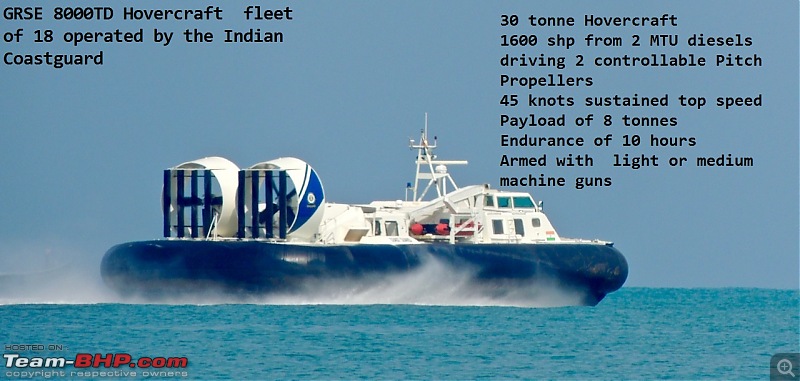
Indian Coast Guard's hovercraft. To give hovercrafts meaningful endurance the Brits pioneered the use of light weight high speed diesels instead of gas turbines. As the lift fans of hovercrafts have become more efficient and the skirts more effective in reducing air leaking out it has become feasible for hovercraft to mount the far heavier diesels and still carry a useful payload.
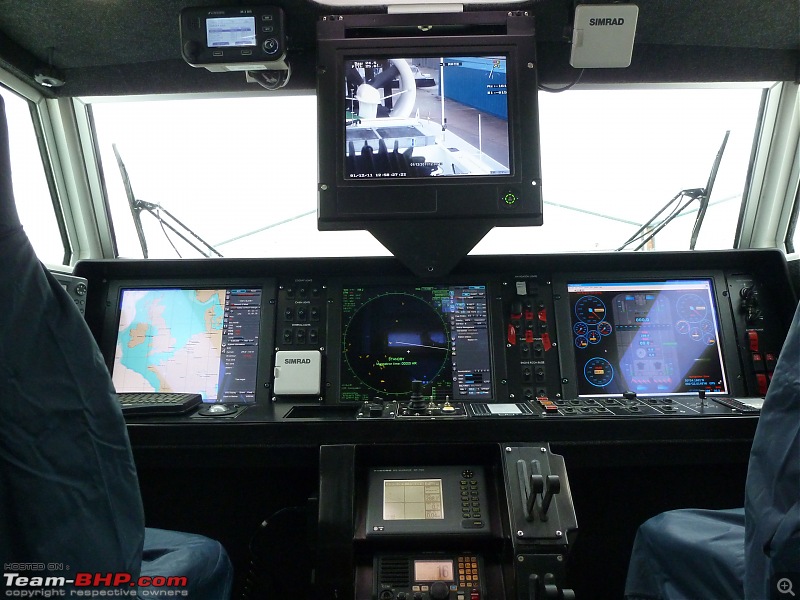
The bridge or cockpit of the hovercraft. Test drive anyone?
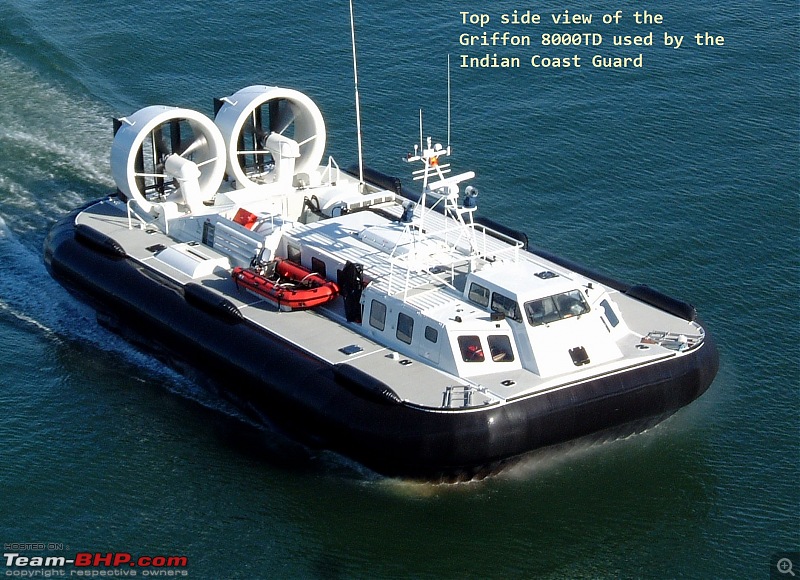
The hovercraft is the ultimate amphibian vessel
Thank you for another very interesting write up. I was just wondering; have hovercraft (of any navy) ever participated in any real war theatres? To me they seem very fragile and vulnerable to any gun fire. I wonder how their damage survivability compares to more conventional ships?
Quote:
Originally Posted by Jeroen
(Post 4262097)
Thank you for another very interesting write up. I was just wondering; have hovercraft (of any navy) ever participated in any real war theatres? To me they seem very fragile and vulnerable to any gun fire. I wonder how their damage survivability compares to more conventional ships?
|
Dear Jeroen, to best of my knowledge they have been used in real war only once. In the late 1960s the US Army deployed 6 SR.N6 British built hovercrafts in the Mekong Delta to keep its marshy banks with tall reeds clear of their hidden enemy. I do not know how successful they were but they did get used (I think from c.1967 to 1972). I agree with you that relative to a ship and relative to forces of the sea a hovercraft is fragile and vulnerable. I simply cannot see them skimming in the kind of seas you have sailed in as an example.
US Army SR.N6 in operation on the Mekong Delta in 1968
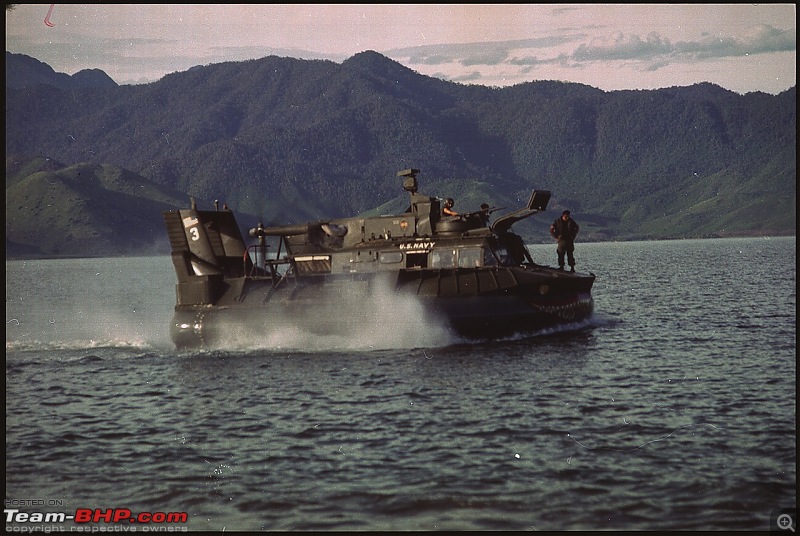
On a related note, BSF uses these tracked amphibious ATV to patrol the marshy sections of Rann of Kutch.
Top speed on tarmac: 100 kmph
Top speed off road: 60 kmph
Top speed on water: 15 kmph
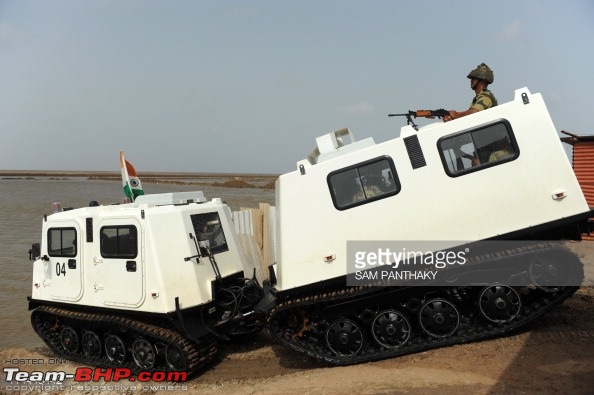
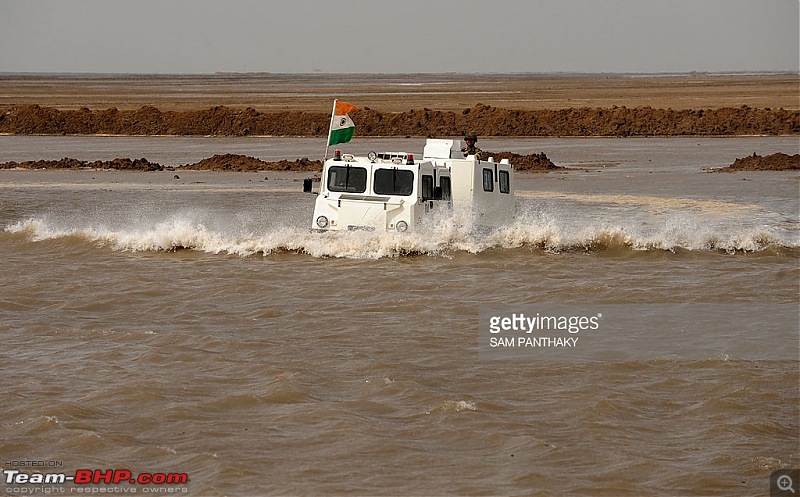
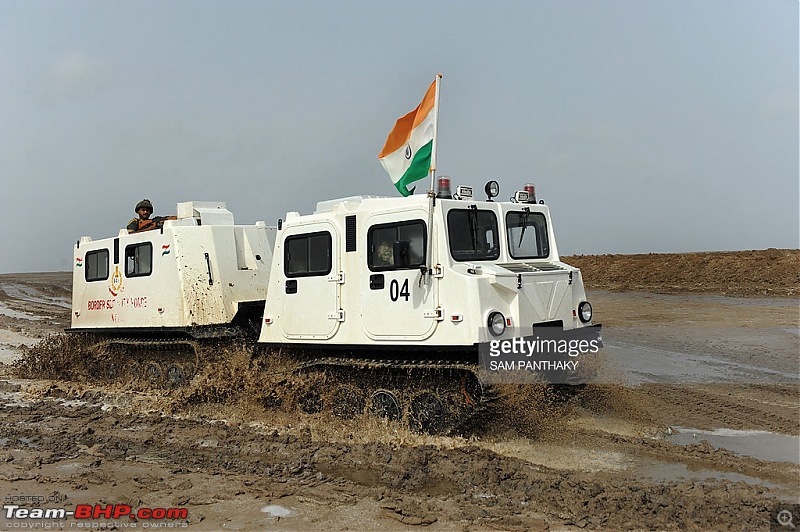
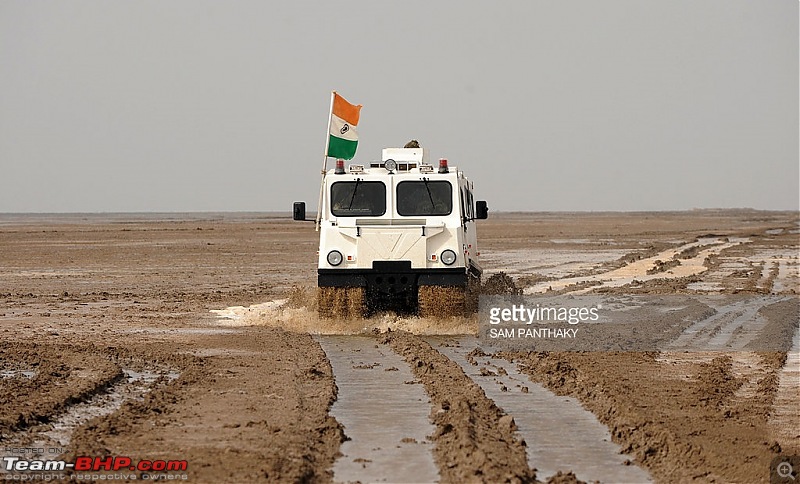
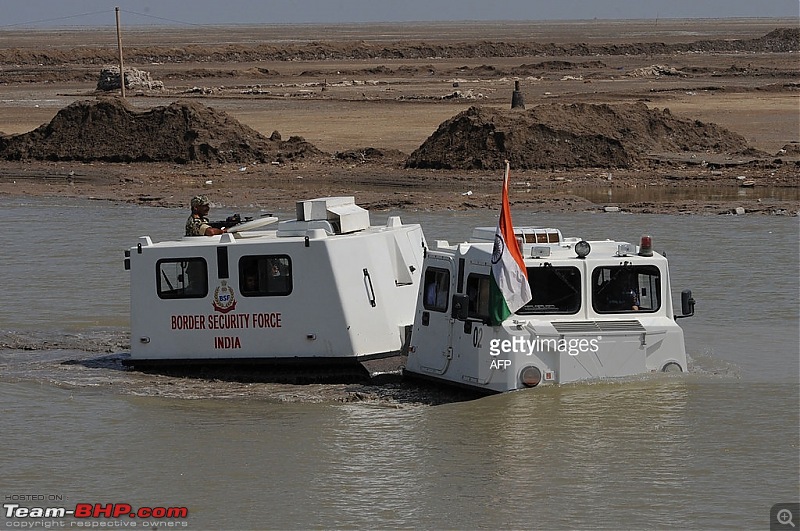
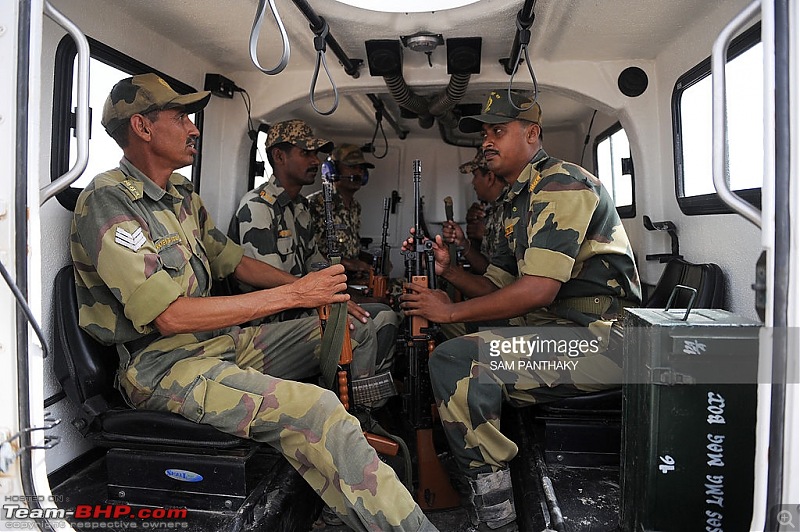
BSF has 15 such ATVs, imported from Italy. Video of the tracked amphibious ATV:
https://www.youtube.com/watch?v=q-CTDkeaAcU
It is cheaper and simpler to operate than a hovercraft, but the obvious disadvantage is that it is much slower than a hovercraft on water
| All times are GMT +5.5. The time now is 21:43. | |


























